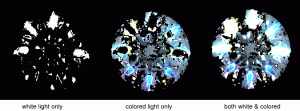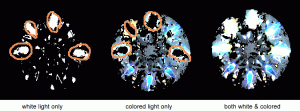First off, sorry if this has been beaten to death and I just missed an old thread. I appreciate any links to them if possible- thanks!
From my brief experience with photospectrometers (what GOG says the B-scope is a version of) I thought the recordings are measured by either the absorbance or transmission/reflection of a substance that are calibrated from a constant (in my case, light was passed through solutions with water being the calibrated zero). The wavelengths being measured come from a 400-700 nm light source.
1. First question- What is the machine calibrated with- a mirror with 100 % wavelength return? Or is the machine calibrated to a database of previous stones or parameters? If the latter, are using different scales for different cuts portraying that b-scopes should only be used as a measure of relevance and not actual light return (otherwise the same scale should be used for all stones to remove any bias of how much is being returned- right?)
2. How does the machine differentiate between ''colored light'' and ''white light'' - when I assume the machine simply measures the magnitude or intesnity of each wavelength being returned? Or are ''clusters'' of light return measured and the ratio of differing wavelengths the determiner of white light (all wavelengths) or colored light (lets say less than 50 % of all wavelengths with equal intesity for hypothetical example)? And would not the overlap of white light return on colored light unfairly boost the actual amount of lets say blue light at 500 nm and give it too high a mark for fire?
I don''t have access to great stones where I live nor would I ever trust my own eyes with so little experience (I, instead, use you all Thus, I have to live by the numbers and get a great stone over the net- which I am most comfortable with. As such, I can''t thank pricescope members enough for your most beneficial information and willingness- and also giving me yet another excuse to sit at my computer whenever I can and do some more research
Thus, I have to live by the numbers and get a great stone over the net- which I am most comfortable with. As such, I can''t thank pricescope members enough for your most beneficial information and willingness- and also giving me yet another excuse to sit at my computer whenever I can and do some more research
 . I think my addiction is getting out of control- Thanks, SJR
. I think my addiction is getting out of control- Thanks, SJR
From my brief experience with photospectrometers (what GOG says the B-scope is a version of) I thought the recordings are measured by either the absorbance or transmission/reflection of a substance that are calibrated from a constant (in my case, light was passed through solutions with water being the calibrated zero). The wavelengths being measured come from a 400-700 nm light source.
1. First question- What is the machine calibrated with- a mirror with 100 % wavelength return? Or is the machine calibrated to a database of previous stones or parameters? If the latter, are using different scales for different cuts portraying that b-scopes should only be used as a measure of relevance and not actual light return (otherwise the same scale should be used for all stones to remove any bias of how much is being returned- right?)
2. How does the machine differentiate between ''colored light'' and ''white light'' - when I assume the machine simply measures the magnitude or intesnity of each wavelength being returned? Or are ''clusters'' of light return measured and the ratio of differing wavelengths the determiner of white light (all wavelengths) or colored light (lets say less than 50 % of all wavelengths with equal intesity for hypothetical example)? And would not the overlap of white light return on colored light unfairly boost the actual amount of lets say blue light at 500 nm and give it too high a mark for fire?
I don''t have access to great stones where I live nor would I ever trust my own eyes with so little experience (I, instead, use you all


















300x240.png)